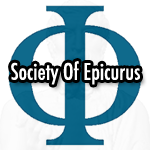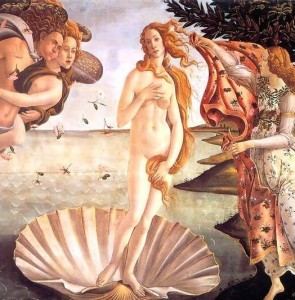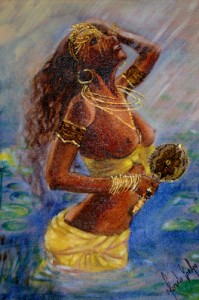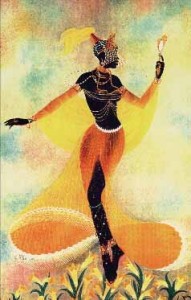The scroll On Music was written by Philodemus as a summary and commentary on four books written on music by various schools. The surviving fourth book comments on the theories on the physical and ethical effects of music presented by Diogenes of Babylon, a Stoic, which equated music with Platonic notions of the beautiful and the good.
Music incites to joy wherever it’s needed … to its highest point …
Diogenes even claimed that music can safeguard one’s virtue and become a constant attribute of virtuous men, and that it can initiate children into virtue and beauty. He said music serves to express courage, shame, or moderation and to imitate them in others, provoking a desired result, that it serves as an “impulse to beautiful acts” and reinforces ethical dispositions just as we believe good association does.
Melody pulls the soul from inertia when it’s at rest and leads it to awaken to such disposition that it may naturally move.
Another interesting part of Diogenes’ theory said that gymnastics is to the body what music is to the soul: it’s an exercise that moves it and constitutes a form of education, keeping it healthy and strong. He also compares them both to painting, which exercises the eye in recognizing beauty. Similarly, music exercises and moves the ear and mind in harmony, beauty, and aesthetics.
From its origins, music was linked to religion and consecrated to the gods, just as theater was. Diogenes argued that, in his day, trumpets were still used for battle and ceremony.
Different Kinds of Music
According to Diogenes, some people classify music as magnificent, as moderate, as courageous, or as disordered and shameful. Some melodies can be used for mating, other melodies incite effeminacy, and others can console the pangs of love.
Music is used to communicate values, patriotism, strength, hatred, pride, and tribal or territorial identities. As we saw in our Reasonings on Piety, Diogenes also believed that the diverse types of melodies produce attunement with the divinity that resonates with the virtues associated with each melody.
… not only do melodies share the fact of being appropriated for the veneration of deities, but also, due to the diversity of their powers, that melody is for that deity …
Following this train of thought, military songs are appropriate to worship Ares; to worship Dionysus, chaotic music is needed, and so on. This notion is accepted in many religious cultures, such as the Gnawa of Morocco, who worship jinns (although orthodox Islam forbids their worship) and classify them according to seven different colors and sets of symbols that represent archetypal forces. For each one of the color suites, a certain set of traditional rhythms are used to induce trance, and only that rhythm must be used. Notions of divine attunement via sound exist also in Hinduism, where specific mantras are used for specific deities; in Sikh faith where singing the names of God is a sacrament; and in some schools of Mahayana Buddhism. Diogenes was expressing beliefs that are still widely held.
Music is a Natural and Unnecessary Pleasure
One has not yet found relaxation or amusement more convenient for free men, certainly, than for one man to sing, for another to play the citar, and for a third one to dance.
Diogenes said that singing and dancing easily incite laughter and liberation from sorrow and tension.
Furthermore, music is also one of the common goods: everyone, in fact–both Greek and Barbarian–uses it and in every age.
Philodemus’ view is that it is clear that music is considered natural, but it is unnecessary for happiness, and unlike poetry, instrumental music can’t communicate philosophy or therapy because it does not employ the use of words and therapeutic philosophers heal through frank criticism, through arguments, through words.
The concept of music as a natural phenomenon deserves further evaluation. We may consider the uses of music in human culture and in the rest of nature. In other species, we see that sounds are employed among both animals and primitive societies to express territoriality. Many animals make calls to mark their territory and to warn potential invaders. Because this imperative protects their food-source, natural selection has favored it, and so it’s not unreasonable that music may have evolved out of this territorial instinct, among other potential reasons and benefits.
Music and its predecessors are also likely to have evoked, for the same reason, a sense of familiarity just as familiar smells and voices can awaken fond memories. Thus, we see that in human culture, patriotism and locality always find expression in music. Even without these values being transmitted, just singing along with friends with abandon can be a source of intense pleasure. Music can be transpersonal, it can create a sense of community, of participating in the collective mind of the tribe or group temporarily. The obvious protection from predators and hostility in nature gained from this must have been the reason why nature favored it by making it a source of great, easy pleasure.
In nature, sound is also used frequently as part of mating rituals and mating calls, and in human culture we also see that music is frequetly used to enhance the mating experience.
As to research on whether music is a natural phenomenon, I was alerted by a fellow Epicurean of a study that proposes that spoken language is a special type of music, and that music and language acquisition are treated as similar processes by the brain.
… newborns are sensitive to the rhythmic components of language and can distinguish between languages based on their rhythmic characteristics (whether or not the contrast includes their native language; Nazzi et al., 1998). Newborns have a preference for their native language as well (Moon et al., 1993), however this has only been explored using languages from two different rhythmic classes. Because the ability to discriminate between two languages of the same rhythmic class (e.g., English and German) does not appear until 4 months of age (Nazzi et al., 1998; Gervain and Mehler, 2010), new borns may show a preference for any language belonging to the same rhythmic class as their native language. If so, then newborns may not prefer their native language per se, but rather the rhythmic characteristics of that language (cf. Friederici et al., 2007). Indeed, infants’ early attention to rhythm (e.g., Ramus and Mehler, 1999; Ramus et al., 1999) suggest that they are absorbing the sonic structure of their native language – its rhythms of stresses, its phonemic character – much in the same way that we listen to music.
… The discrimination of consonance and dissonance has been cited as a human universal, with dissonance treated as displeasing (Fritz et al., 2009).
It’s too early to speak about the potential uses of music therapy, both in infants and adults, in neuroplasticity and in shaping the brain for this or that long-term purpose, but these studies suggest very early specialization for the speech and musical sounds of one’s native culture, which probably links music and speech to the territorial anticipations discussed earlier.
On the Origins of Dance
They enjoy song but exclude from nature that which incites us to the practice of music.
The controversy on the origins of dance reveals details about the different worldviews of the Stoics and Epicureans. Epicureans in antiquity did not only dedicate themselves to the study and defense of a natural cosmology and natural origins of things in order to challenge the fables. There was a tendency among other schools to rationalize origin stories and to assume that all of man’s acts were rational or calculated. This is what Philodemus says:
It is not true that the men of yore exercised in dance … with the purpose not only of seeing their bodies gain utility and to reach the dispositions of good people … but also to carry in their soul equally the good performance that they saw manifesting throughout their bodies, and to try to keep their soul constantly beautiful for the rest of their lives.
In fact, neither of these reasons was the origin of humanity’s first impulse to dance, or of its transmission by those who received it … It was, on the contrary, their ignorance of nature and exultation that brought them to form, in a manner that was instinctive and unthinking, as if forced, a circle in order to produce with their hands, their feet, and other parts of the bodies the organized movements …
It seems like what is being said here is that there are natural and human experiences that do not need to be rationalized, or planned. There is no need to project our calculated behavior against primitive humans … and that it’s okay that we are instinctive, natural beings. There’s almost an innocence that is implied here.
Notice that nothing is being said against dance as a practice, but what Philodemus criticizes is the lack of spontaneity that is presumed by the Stoics, the belief that man is only and always rational and never an instinctive animal with natural behaviors. There is nothing wrong with music being wild, natural, primal, a blissful act of savagery and instinct. Perhaps that’s precisely why it helps to relieve tension in the body and soul; perhaps there lies its therapeutic benefit.
And so, ultimately, the controversy on the origins of dance sheds light on how the two schools relate to nature, and on the primacy of pleasure for us versus the primacy of reason for our Stoic brethren. If nature guides an Epicurean to discover the bliss and release of dancing, then the Epicurean just dances, he or she surrenders and fully enjoys the emotion and the experience. The moment we rationalize what we’re doing, we established a distance with the experience that impedes its full enjoyment.
We must not force Nature but persuade her. We shall persuade her if we satisfy the necessary desires and also those bodily desires that do not harm us while sternly rejecting those that are harmful. – Vatican Saying 21
Primitive men may have philosophized about dancing after they had danced, but it’s not likely that they calculated the blissful trance in advance with the goals that Diogenes supposed.
Later in the work, Philodemus cites Democritus’ argument that music was a recent invention because it could have only emerged after people had time for leisure.
Philodemus’ Critique of Diogenes of Babylon
If they say that only these irrational realities provide harmony to the soul, then their error is double: it means those who can’t sing or dance, or who are unfamiliar with music, can’t be virtuous.
After summarizing Diogenes’ scroll, Philodemus argues that music (by which he means instrumental music, as he treats lyrics in a separate scroll on Poetry) is not capable of making us better or worse in character. This is one of his key points, and it’s because of the lack of words, of lyrics.
This view is consistent with the view that therapeutic philosophy heals with words, with arguments. Therefore, music can not replace philosophy in its healing role: it can not, by itself, fix the human character. It can only have therapeutic value if it incorporates the words of the healing doctrines of philosophy.
And those that say that we are sweetened by music because she softens our souls and would deprive them of their savagery, one may consider them perfect imbeciles. In fact, it is only reason–because she teaches that none of the strange things that unreason invents has been produced by nature and that, furthermore, nothing of what she produces has any importance–that can perfectly reach this result, once it has attained its perfection, and while she is still on the path to perfection, it can alleviate in proportion.
In our tradition, reason or logic is not included in the Canon, in the set of faculties used to apprehend reality directly. However, this does not mean that we do not appreciate reason, as some opponents of our school insinuate. We simply do not accept reasonings that do not derive insight from the study of nature, from evidence. Reasoning without connection to reality only leads to theology and superstition.
Reason is essential for the therapeutic process. It is through reason, based on evidence, that we produce arguments to heal the diseases of the soul. Music, being irrational, can not be considered therapeutic in the way that we understand therapy. It’s philosophy, not music, that educates. Philodemus refused to recognize musicians as philosophers.
Philodemus also denies that music can deliver us from a Bacchic trance, or a warrior’s fury for the same reason: only “adapted speech liberates from trance”. Similarly, in religious music, it’s poems that have “the beautiful part” in worship, and not the melodies, which provides only “the approval of the ear” according to Philodemus.
Diogenes had argued, by citing popular fables, that certain kinds of music would encourage temperance and chastity. Philodemus replies that music does not produce the virtue of temperance, and argues this by saying that if we were to base our views on fables, then hunting would produce temperance because Artemis is a virgin Goddess and a huntress.
Elsewhere, Philodemus also states that musical harmony has nothing to do with cosmology. Apparently some Stoics were repeating Pythagorean doctrines about the “music of the spheres” and other such beliefs. An accusation of being rustic and unsophisticated, due to their rejection of philosophical theories related to music, was presented against the Epicureans, to which Philodemus replied:
The Epicureans do not underestimate music for lack of culture; to them, only philosophy counts.
Philodemus does acknowledge that loud noise can create mental disorder and chaos, but rejects every theory of musical psychology as vain, and concludes the work by accusing music of impracticality.
The Canon’s Verdict
Let’s now take the evidence-based approach to music. While combing through my collection of music and considering the effects that songs have in my person, I found that melodies anchor memories and experiences of people and places from the past, including certain friends, a certain generation (such as, “the 80s” and “the college years”), and certain ethnicities (Afro-Cuban, African American, Spain, India). There’s also music that I associate with women, and other music that I associate with men. Then there are moods: there’s happy, devotional, playful, urban, comedic, political, and music that inspires solidarities.
There’s highly individualistic, original and creative music (Bjork, Cirque du Soleil) which did not fit any other category, some of whose lyrics did give messages about self-sufficiency, independence, and communicated or implied other values. Wherever music that I listen to transmits values or solidarities, it does so through the lyrics, not through the melody. On that basis, I coincide with Philodemus’ opinion regarding how melody without words does not seem to transmit virtue or vice.
However, I did come across several articles while doing research for and writing my book according to which mantra recitation changes the brain faster and more dramatically than previously thought, and has other proven health benefits.
Neuroscientist Marian Diamond, from the University of California, found chanting helps block the release of stress hormones and increases immune function, while another neuroscientist, Dr Alan Watkins at Imperial College London, showed that while chanting your heart rate and blood pressure will drop to its lowest of the day – Women’s Fitness Magazine
Whether it’s praying the rosary, chanting the nembutsu or the Hare Krishna mantra, the documented benefits are the same: chanting has medicinal properties. While this does not confirm the supernatural beliefs of the Catholics, Buddhists or Hare Krishnas, it does grant scientific merit to the practice of chanting and reciting mantras. So we should “Chant and Be Happy”, like the Hare Krishnas (and the Beatles) advised.
Practitioners of bhakti yoga (devotional yoga) in the Vaishnava and other Hindu traditions report that singing devotional songs is a way to channel and express love, that devotion “purifies the emotions” (helping to release negative ones and add healthy ones), that it’s like exerting a muscle, and that people can become happier and more loving as a result of this practice.
There’s a humanist alternative to these practices. Epicurus recommended the use of mnemonic devises (like repetition of short adages) to aid in memorizing his teachings and also encouraged the grateful remembrance of fond and happy memories as a spiritual practice. Repetition of adages as a meditation would not only help to memorize them but also, according to the above cited research, would produce a pleasant state of mind. Philodemus may have underestimated the potential benefits or uses of these practices, perhaps having had little or no experience with them, but he coincided with Epicurus that it’s the words and their content that heal, not the melodies or the rhythm.
Philodemus would have been proved wrong when it comes to his disputing Diogenes’ argument that music can move the body and soul. Research demonstrates that music enhances endurance during workout by about 15 percent:
Music distracts people from pain and fatigue, elevates mood, increases endurance, reduces perceived effort and may even promote metabolic efficiency. When listening to music, people run farther, bike longer and swim faster than usual—often without realizing it. In a 2012 review of the research, Costas Karageorghis of Brunel University in London, one of the world’s leading experts on the psychology of exercise music, wrote that one could think of music as “a type of legal performance-enhancing drug.”
Other studies demonstrate that music leads to greater productivity, but that only works for repetitive tasks. In other instances at work, it can be a distraction. And so music may be generally helpful to control or regulate hedonic tone in our day-to-day lives, if applied correctly.
The lack of a comprehensive musical theory among ancient Epicureans does not mean that future Epicurean lovers of art may not, at some point, develop their own aesthetic theories based on the Canon and on available research.
We conclude that music is a natural and unnecessary pleasure and that, while music can not replace philosophy in its healing role or fix the human character, it can increase endurance in some instances and can have therapeutic value if it incorporates the healing words of philosophy.
Based on the French translation in Les Epicuriens of the original scroll from Herculaneum titled La Musique.
Further Links:
Music Oomph Published an Essay titled 21 Ways Music Makes You More Productive at Work





